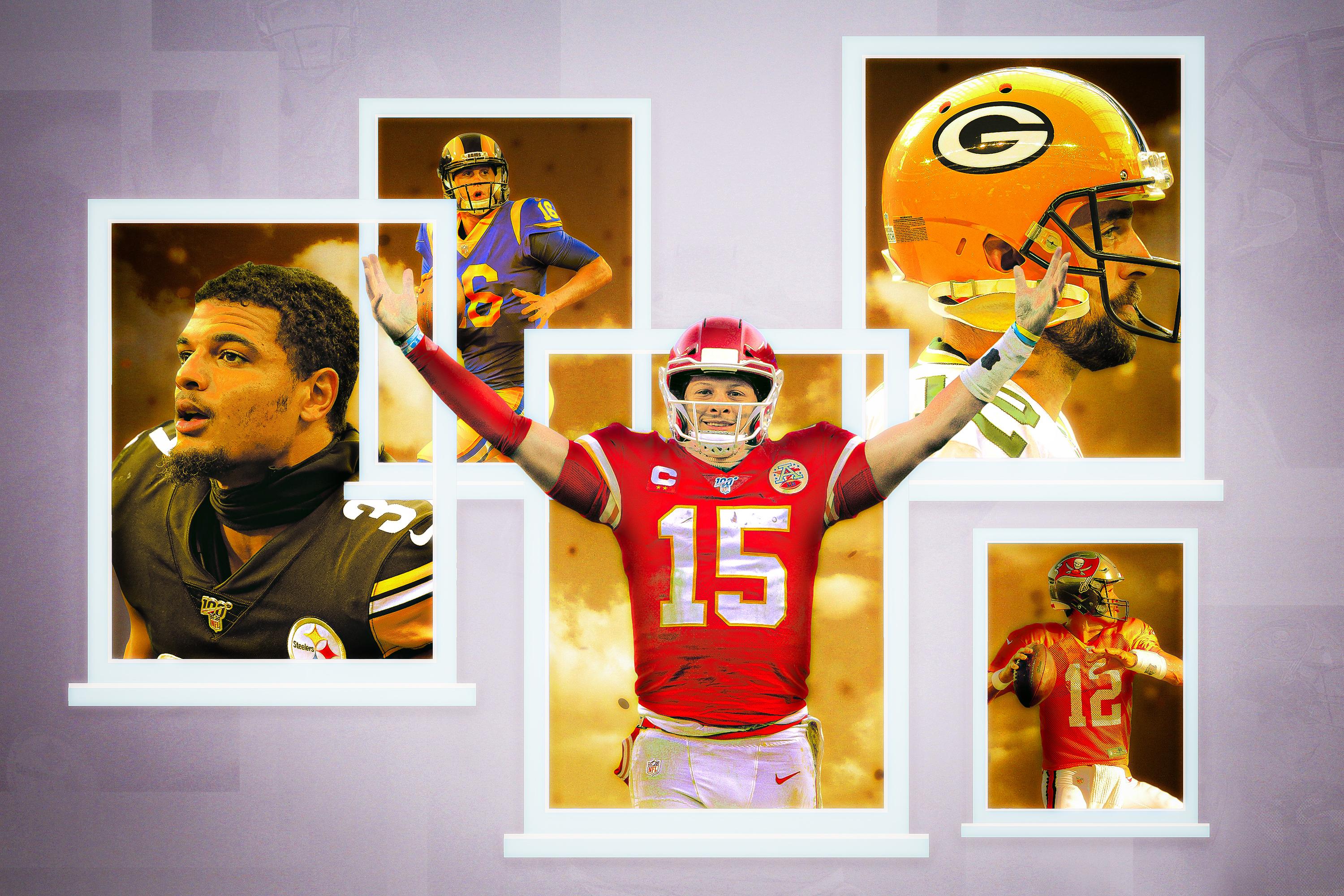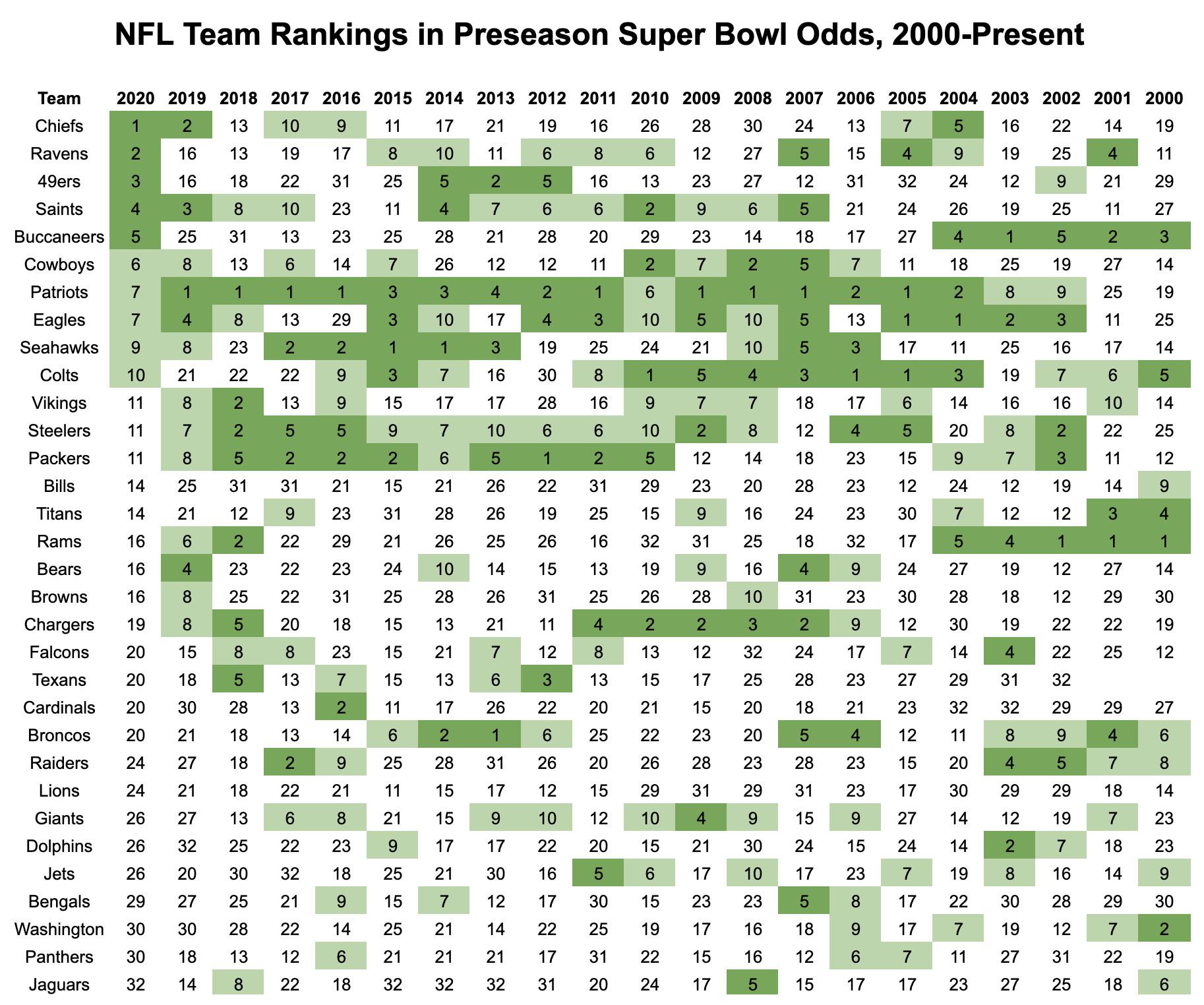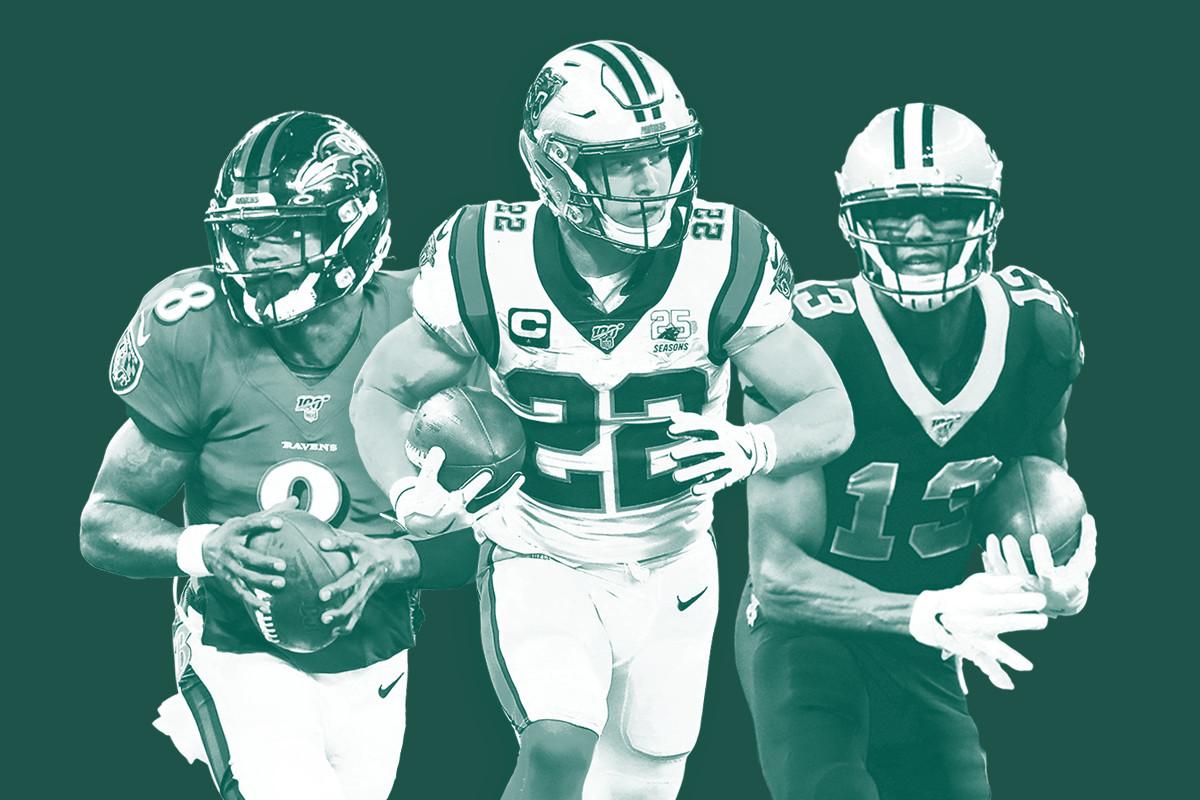
In the past 20 NFL seasons, only five teams have won the Super Bowl without first being in the top 10 of that preseason’s Super Bowl odds. Of those five (the 2017 Eagles, 2011 Giants, 2007 Giants, 2001 Patriots, and 2000 Ravens), just one was ranked outside the preseason top 15 (the ’01 Pats). The NFL bills itself as a parity-driven league in which any team can win on any given Sunday, but only a handful of squads can actually win the Super Bowl. And most years, we go into Week 1 already knowing which squads those are.
This season, the list of top title contenders—as determined by betting odds—includes expected powerhouses (the Chiefs, Ravens, 49ers, and Saints) as well as some new faces (the Buccaneers) and long-standing contenders (Patriots, Seahawks). Their title windows are wide open, at least in the minds of gamblers. But when the Chiefs handed Patrick Mahomes a 10-year, $500 million contract this offseason, it got me thinking: Just how long of a window does Kansas City have?
A look back at the past can help. Here’s a timeline of preseason Super Bowl odds since the turn of the century:

There’s a lot to take in here. The long-standing dynasties stand out (hello, New England), but the lessons that can be learned from the quick flameouts (remember when the Cardinals were a top-two title favorite?) are just as important. From a 40,000-foot view, there are five broad categories of title windows that stand out. Let’s break them down.
The Future Hall of Fame Quarterback Dynasty Squads
Recent Examples:
- Patriots (2002-20)
- Packers (2010-19)
- Saints (2007-14, 17-20)
- Colts (2004-11)
Breaking news: Long NFL title windows generally correlate with great quarterback play. Other than perhaps the Eagles in the 2000s, every team that has maintained a long run of competitive success has had one of the league’s best passers under center. And even Philly had the underrated Donovan McNabb. But this tier is made up of guys like Tom Brady, Aaron Rodgers, Drew Brees, and Peyton Manning. It makes sense that the league’s best quarterbacks also had the longest and most wide-open title windows.
This may seem like an obvious observation, but it’s an important one: This should have a big effect on how teams construct their rosters. By and large, if a team doesn’t employ one of the best quarterbacks in the league, it shouldn’t expect its title window to be open for more than a few seasons.
The Really Great Rosters That Can Hang Around
Recent Examples:
- Eagles (2002-05, 2007-12)
- Steelers (2008-19)
- Chargers (2006-11)
- Cowboys (2006-10)
Switching sports for a second, I often find myself thinking of the 2010-11 Dallas Mavericks when considering title windows. That franchise had made the playoffs in each of the 10 seasons before they won that NBA Finals, but previously was never quite good enough to get over the hump.
By 2010, Dirk Nowitzki was 32 and was just starting to exit his prime. It felt like Dallas’s chances were all but over. But that season, the stars aligned for the Mavericks. A number of NBA teams were in a period of transition, with the Lakers’ championship roster crumbling and LeBron James still working out the kinks in Miami. Dallas’s win showed that sometimes a team doesn’t need to dominate an era to win a title—they can hang around long enough and wait for things to break in their favor.
That’s how I see this group of teams. These squads were good enough to cause trouble in the playoffs for a decently long period of time. And if things had gone right, they could have made a deep run or even won a ring. The Steelers actually did just that in 2008—and they could even do so again this season. They’re on the fringes of Super Bowl contention with perhaps the best defense in the NFL, some promising playmakers, and an above-average offensive line. Of course they’ll be fending off the powerhouse Ravens in their division, but much like Nowitzki and Co. nine years ago, a few fortunate breaks could push this team toward the top of the pack.
The Inexpensive QB Advantage
Recent Examples:
- 49ers (2012-14)
- Seahawks (2013-15)
- Colts (2014-15)
- Rams (2018-19)
- Eagles (2018-19)
This is the holy grail of modern roster construction. As the rest of the teams in this piece show, having a great quarterback is the key to a sustained title window. And having a great quarterback on a deal that pays him pennies allows a franchise to quickly build an elite roster around their passer, vaulting the team into playoff contention in short order.
The teams I’ve noted above never had a cap hit above seven figures for their QBs. Some even got as low as six figures. In the NFL, that’s basically free, and it opens plenty of cap space for an all-in Super Bowl push. All of these teams had defenses that ranked in the top 10 in DVOA (except for the Eagles and Colts, and Indy just missed that mark). And also except for the Colts, they all made at least one Super Bowl appearance.
But what happens when the quarterbacks for these teams get big deals? The Seahawks are the blueprint for how to transition from one type of title window to another. Russell Wilson is one of the best players in the league, and Seattle’s Super Bowl window is still open even with him costing the team $31 million in cap space this year. Even so, it’s not as wide open—the Seahawks haven’t made an NFC championship game since they paid their quarterback.
The All-In Veteran Push
Recent Examples:
- Vikings (2008-10)
- Broncos (2012-15)
- Buccaneers (Present)
This is the easiest type of title window to visualize. It happens when an older quarterback who still has a few good seasons left is on a new team with every incentive to win now. When the Vikings brought in Brett Favre in 2009, they’d just gone 10-6. The Broncos were coming off a playoff appearance when they added Peyton Manning, and they spent the next few years signing all kinds of free agents to bolster the roster and give themselves the best Super Bowl odds. The Buccaneers weren’t so successful last season, but they have one of the best groups of pass catchers in the league to pair with Tom Brady.
This tier is a title window not just for a team, but for an aging, elite quarterback as well. Manning won a Super Bowl—mostly thanks to an elite defense—and appeared in another. Favre was thisclose to winning the NFC championship game. Time will tell if Brady and the Buccaneers can find a similar level of success.
The Blips on the Radar
Recent examples:
- Jaguars (2018)
- Panthers (2016)
- Cardinals (2016)
- Browns (2019)
- Bears (2019)
- Dolphins (2015)
It’s incredibly difficult to maintain success in the NFL. Most teams that get good stay good for only a season or two. And there are a ton of NFL teams that showed up as a top-10 title contender only to fall off a year or two later. You’ll notice that some of these teams have a “window” that’s the year after when their window should be. The Panthers went 15-1 and reached the Super Bowl in 2015, not 2016. The Jaguars peaked with an AFC championship game in 2017, not 2018. That makes sense—these are preseason title odds, and those teams were surprises in the years they made deep playoff runs. It wasn’t until the following season that such teams garnered hype.
That’s also a great indicator of just how quickly a title window can disappear. In 2016, the Panthers won six games. The Cardinals won seven. The Jaguars won five in 2018. The Bears won eight last year. And on and on it goes—a team can have a good season, but that doesn’t mean they’ll have a lasting shot at a title. It’s imperative that general managers understand the difference between having a real title window, or just a squad that overachieved for one season.
Today’s Title Windows
Here are the teams with top-10 Super Bowl odds this season:
- Chiefs
- Ravens
- 49ers
- Saints
- Buccaneers
- Cowboys
- Patriots
- Eagles
- Seahawks
- Colts
It’s highly likely that the champion will be one of those squads above. But where do these teams fit among the above categories? How long will their windows be open?
When you look at NFL title windows in this way, Patrick Mahomes’s mind-boggling contract doesn’t seem so, well, mind-boggling. Mahomes has shown enough in two seasons to prove that he’s the future of the NFL and one of the most gifted passers to ever step onto a football field. And while his rookie contract has helped the Chiefs field a Super Bowl roster, the team should also expect to be in contention even when Mahomes’s cap hit rises north of $40 million and even $50 million. He’s just that good.
If anything, the length of the contract gives the Chiefs a major roster-building advantage, because they know exactly what Mahomes will cost them for a long time. Recent history shows that a team with a quarterback as good as Mahomes can contend for championships for more than a decade. The Chiefs are planning for exactly that.
For these other teams, it’s more of a mixed bag. The Ravens could also be in the Future Hall of Fame QB tier with Lamar Jackson—but they probably want to wait a season or two before they hand him a decade-long extension, especially since Baltimore currently has the second-lowest offensive payroll of any team in football. The Ravens have plenty of roster flexibility right now, but that won’t be the case once they hand Jackson a big deal.
The Niners can’t be too confident in Jimmy Garoppolo. In his first full year as a starter, he ranked 10th in adjusted net yards per attempt and 15th in PFF grades. This roster is stacked from top to bottom, but recent history shows that without a top-tier quarterback, San Francisco’s Super Bowl window probably won’t stay open for long. If Garoppolo doesn’t make a big leap in his level of play soon, the Niners will need to find a better QB or go all in now.
Speaking of short windows, the Saints and Buccaneers have QBs who are in their twilight years. New Orleans has been running a high-wire act for some time. The Buccaneers now have their own going on, too.
The Cowboys feel like they belong in the “hanging around” tier. Dak Prescott is a great quarterback and the team has a ton of playmakers on offense, a great offensive line, a solid-if-not-spectacular defense, and a brand-new head coach. On paper, they look good enough to compete over the next few years. And if Prescott is as good as I think he is, that could extend to the long term—which makes Dallas’s decision to not reward him with a long contract extension this offseason confusing.
The Patriots have Bill Belichick. That’s why they’re on here. The Eagles are transitioning out of the inexpensive QB phase and into the next stage of their development. How long they remain a title contender will depend heavily on how good Carson Wentz actually is. The Seahawks have Russell Wilson and a long history of success. Their window isn’t wide open this year, but they have enough good pieces in place that they should be in the mix every season, and should plan for a long period of contention. The Colts round out the list with a mini all-in push behind Philip Rivers and a roster that is flush with talent.
One of these squads should win the Super Bowl this season, but only some of them will still be in contention in a few years. Which category of title window a team fits into should help that franchise decide whether right now is a good time to push their luck—or whether they should give their quarterback a decade-long deal and plan for a potential dynasty.


